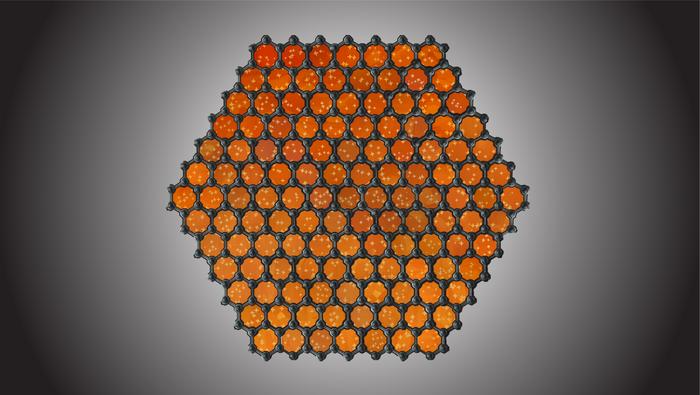In a recent paper published in Nature, engineers at Columbia University, along with collaborators at the University of Montreal and the National Institute of Standards and Technology, discovered an oxygen-free chemical vapor deposition (OF-CVD) technique. The technique can produce high-quality graphene samples on a large scale, which establishes a direct correlation between oxygen and graphene quality and shows how trace oxygen impacts the growth rate of graphene.

The Hone lab at Columbia Engineering created over 100 identical graphene samples with their oxygen-free chemical vapor deposition method. Image Credit: Jacob Amontree & Christian Cupo, Columbia University.
Graphene, a single layer of carbon atoms, has been hailed as “the wonder material of the 21st century.” Since its discovery in 2004, it has been hailed for several exceptional qualities, including exceptionally high electrical conductivity and remarkable tensile strength. Graphene could revolutionize electronics, energy storage, sensors, biomedical devices, and other industries. However, it has a dark secret: it is unclean.
We show that eliminating virtually all oxygen from the growth process is the key to achieving reproducible, high-quality CVD graphene synthesis. This is a milestone towards large-scale production of graphene.
James Hone, Study Senior Author and Wang Fong-Jen Professor, Mechanical Engineering, Columbia Engineering
Historically, there have been two methods used to synthesize graphene. There is the “scotch-tape”` method, which involves using household tape to peel individual layers from a bulk sample of graphite, which is the same material as pencil lead. Exfoliated samples of this kind can be very pure and devoid of contaminants that would otherwise affect the advantageous characteristics of graphene. They are better suited for lab research because they are typically too small - just a few tens of micrometers across - for industrial-scale applications.
About 15 years ago, researchers created a technique to synthesize large-area graphene, which has gone from lab experiments to practical applications. In CVD growth, a carbon-containing gas, such as methane, is passed over a copper surface. The gas's temperature is raised to a point where the methane fragments and carbon atoms reorganize to form a single layer of graphene that resembles a honeycomb.
It is possible to scale up CVD growth to produce graphene samples with a size of centimeters or even meters. However, despite years of work from research groups worldwide, CVD-synthesized samples have struggled with issues of reproducibility and variable quality.
Oxygen was the problem. Co-authors Richard Martel and Pierre Levesque of Montreal had previously demonstrated that minute concentrations of oxygen could impede growth and even remove graphene. Therefore, approximately six years ago, Christopher DiMarco, GSAS’19, designed and constructed a CVD growth system that allowed for precise control over the amount of oxygen added during the deposition process.
DiMarco's work was carried out by current Ph.D. candidates Xingzhou Yan and Jacob Amontree, who enhanced the growth system. They discovered that CVD growth was consistently faster when trace oxygen was removed. Additionally, they investigated the kinetics of oxygen-free CVD graphene growth and discovered that growth rate could be predicted over a variety of parameters, such as temperature and gas pressure, using a straightforward model.
The OF-CVD-grown samples’ quality turned out to be almost the same as that of exfoliated graphene. Their graphene, produced in cooperation with physics department colleagues at Columbia, provided compelling evidence for the fractional quantum Hall effect in the presence of magnetic fields—a quantum phenomenon that was previously worked in extremely high-quality, two-dimensional electrical systems.
The last piece of the jigsaw to utilize this amazing material is for the team to devise a clean way to transfer their excellent graphene from the metal growth catalyst to other functional substrates like silicon.
We both became fascinated by graphene and its potential as undergraduates. We conducted countless experiments and synthesized thousands of samples over the past four years of our Ph.Ds. Seeing this study finally come to fruition is a dream come true.
Amontree and Yan
Journal Reference:
Amontree, J., et al. (2024) Reproducible graphene synthesis by oxygen-free chemical vapor deposition. Nature. doi.org/10.1038/s41586-024-07454-5